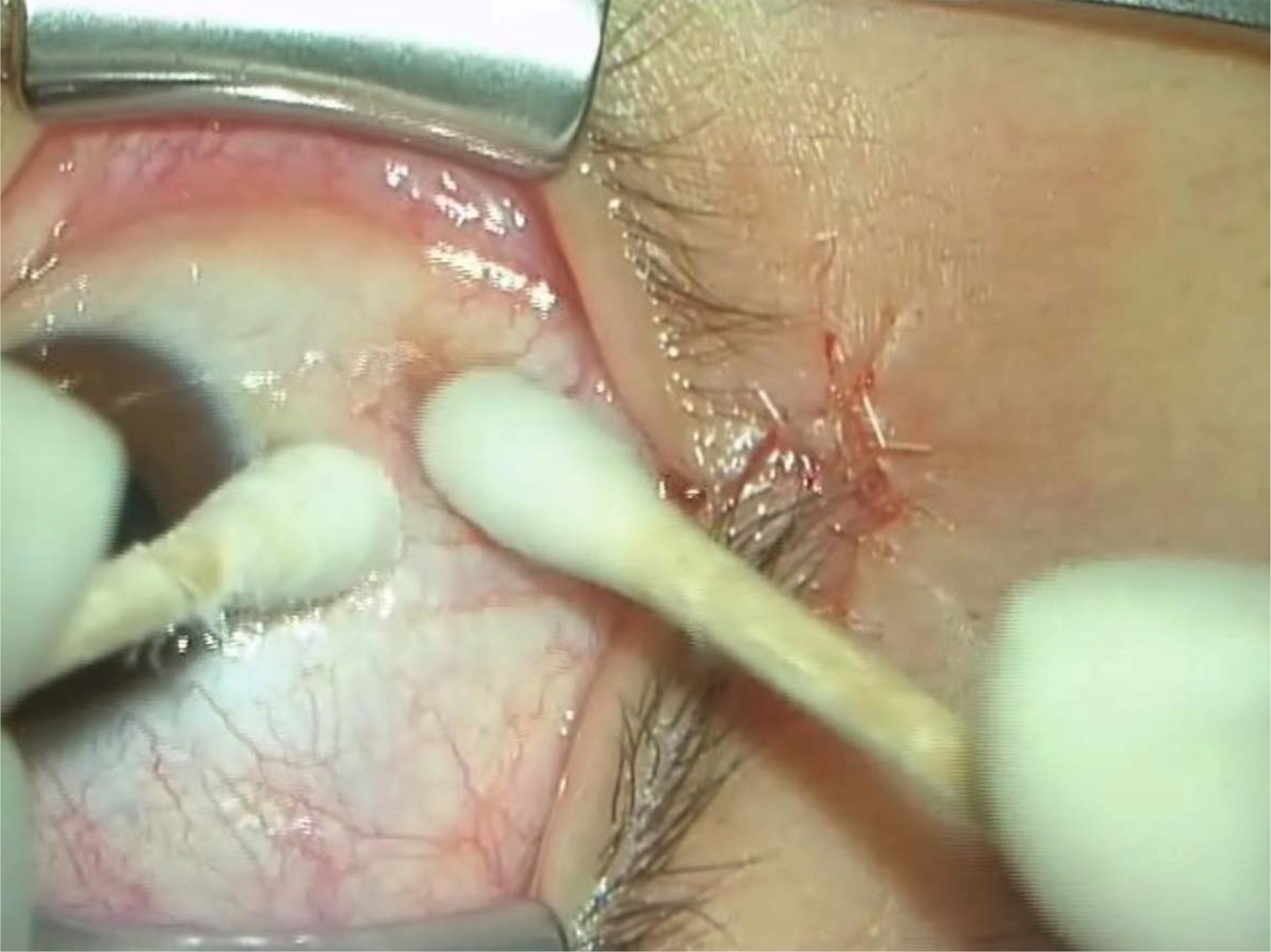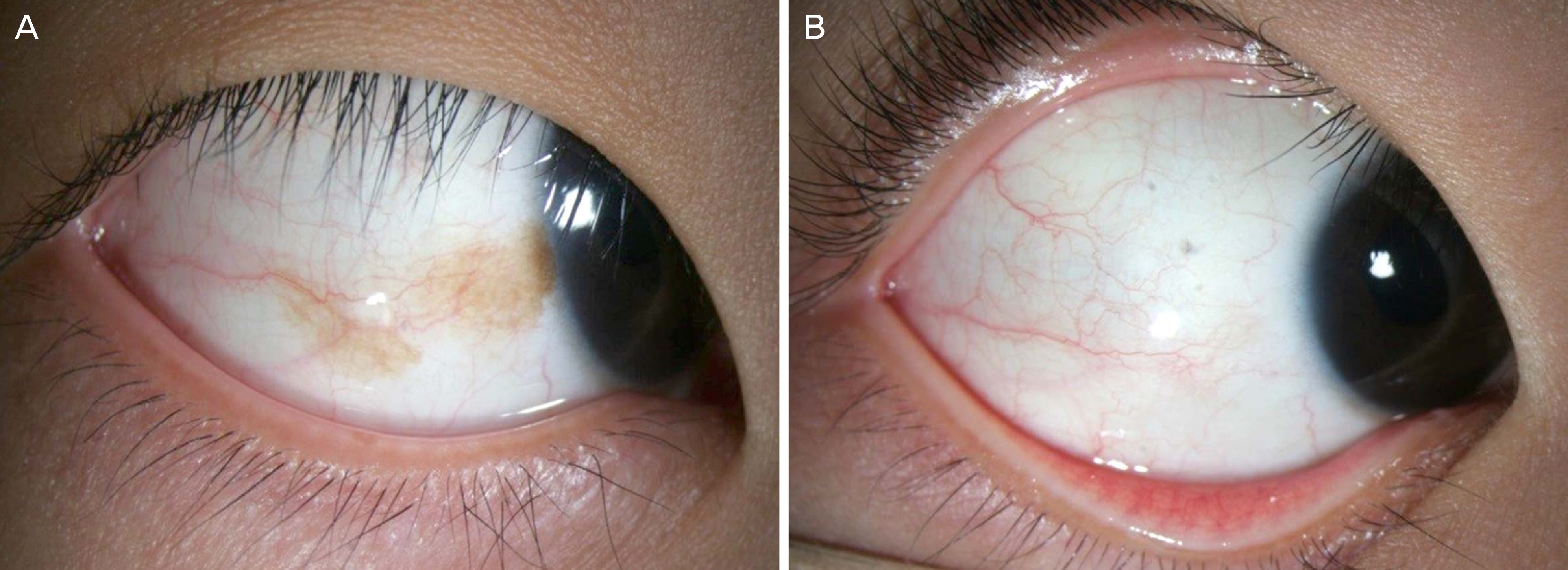J Korean Ophthalmol Soc.
2016 May;57(5):705-709. 10.3341/jkos.2016.57.5.705.
Surgical Outcome of Chemical Peeling of Conjunctival Nevus with Alcohol
- Affiliations
-
- 1Department of Ophthalmology, Wonkwang University School of Medicine, Iksan, Korea. sangduck@wonkwang.ac.kr
- 2Institute of Medical Science, Wonkwang University, Iksan, Korea.
- KMID: 2212711
- DOI: http://doi.org/10.3341/jkos.2016.57.5.705
Abstract
- PURPOSE
To evaluate the efficacy of chemical peeling using 83% alcohol in patients with conjunctival nevus.
METHODS
Chemical peeling using 83% alcohol was performed in 13 patients (13 eyes) who were clinically diagnosed with benign conjunctival nevus. Effects of procedure and recurrence were analyzed by retrospectively reviewing medical records. After topical anesthesia, conjunctival nevus was eliminated by rubbing with an alcohol-soaked cotton ball. Conjunctival nevus close to corneal limbus was removed by 15th blades of scalpel.
RESULTS
A total of 13 patients, 8 males, and 5 females had a, mean age of 27 years (12-54 years). Eights of the eyes were right eyes, and 5 were left eyes. No recurrence was detected in any patient during the follow-up period (mean 54 months), and there were no cases of conjunctival scar, granuloma, or permanent conjunctival injection. All patients were satisfied with the cosmetic outcome of chemical peeling.
CONCLUSIONS
Chemical peeling using alcohol for conjunctival nevus is a non-invasive technique and has benefits such as no intraoperative hemorrhage, low recurrence rate, easy method, and good cosmetic results. Based on these, this procedure is a good method for eliminating conjunctival nevus.
Keyword
MeSH Terms
Figure
Reference
-
References
1. Shields CL. Fasiuddin AF. Mashayekhi A. Shields JA. Conjunctival nevi: clinical features and natural course in 410 consecutive patients. Arch Ophthalmol. 2004; 122:167–75.2. Grossniklaus HE. Green WR. Luckenbach M. Chan CC. Conjunctival lesions in adults. A clinical and histopathologic review. Cornea. 1987; 6:78–116.3. Jeoung JW. Kim TI. Lee JH, et al. Argon laser ablation of conjunctival nevus. J Korean Ophthalmol Soc. 2004; 45:1989–94.4. Yeo HE. Lee SH. Kwon JW. Clinical features of conjunctival nevi in Korean patients. J Korean Ophthalmol Soc. 2009; 50:1510–13.
Article5. Park JJ. Jeong BJ. Seo HD, et al. Treatment of conjunctival nevus with argon laser. J Korean Ophthalmol Soc. 2004; 45:1995–9.6. Jo DH. Lee MJ. Han YK. Kwon JW. Surgical treatment of extensive conjunctival melanocytic nevus mimicking conjunctival melanoma. J Korean Ophthalmol Soc. 2010; 51:764–8.
Article7. Tomita M. Goto H. Muramatsu R. Usui M. Treatment of large conjunctival nevus by resection and reconstruction using amniotic membrane. Graefes Arch Clin Exp Ophthalmol. 2006; 244:761–4.
Article8. Kim SK. Choi HJ. Kim MK. Wee WR. A case of giant conjunctival nevus mimicking malignant melanoma. J Korean Ophthalmol Soc. 2014; 55:124–8.
Article9. Levecq L. De Potter P. Jamart J. Conjunctival nevi clinical features and therapeutic outcomes. Ophthalmology. 2010; 117:35–40.10. Kurli M. Finger PT. Melanocytic conjunctival tumors. Ophthalmol Clin North Am. 2005; 18:15–24. vii.
Article11. Shields CL. Demirci H. Karatza E. Shields JA. Clinical survey of 1643 melanocytic and nonmelanocytic conjunctival tumors. Ophthalmology. 2004; 111:1747–54.
Article12. Tanaka M. Okisaka S. Nakayasu K. Kanai A. Clinical importance of inclusion cysts of nevi in bulbar conjunctiva. Nippon Ganka Gakkai Zasshi. 1995; 99:190–4.13. Choi JH. Chi MJ. Beak SH. Clinical analysis of benign eyelid and conjunctival tumors. J Korean Ophthalmol Soc. 2003; 44:1268–77.14. Lee JC. Chyung EJ. Park SR. Clinical and histopathological observation on acquired melanocytic nevus (1975-1985). Korean J Dermatol. 1988; 26:874–8.15. Shields JA. Shields CL. De Potter P. Surgical management of conjunctival tumors. The 1994 Lynn B. McMahan Lecture. Arch Ophthalmol. 1997; 115:808–15.16. Gerner IL. Norregaard JC. Jensen OA. Prause JU. Conjunctival nevi in Denmark 1960-1980. A 21-Year follow-up. Ugeskr Laeger. 1998; 160:3728–31.17. On YH. Shin HH. Clinical effects of argon laser photocoagulation for the conjunctival melanotic tumors. J Korean Opthalmol Soc. 1984; 25:201–5.18. Kim JH. Hahn TW. Excimer laser ablation of conjunctival epithelial melanosis. J Cataract Refrect Surg. 1993; 19:309–11.
Article19. Michels RG. Maumenee AE. Retrobulbar alcohol injection in seeing eyes. Trans Am Acad Ophthalmol Otolaryngol. 1973; 77:OP164–7.20. Clarinbold TV 2nd. Laser-assisted subepithelial keratectomy for the correction of myopia. J Cataract Refract Surg. 2002; 28:18–22.21. Kornilovsky IM. Clinical results after subepithelial photorefractive keratectomy (LASEK). J Refract Surg. 2001; 17:2. S222–3.
Article22. Campos M. Raman S. Lee M. McDonnell PJ. Keratocyte loss after different methods of de-epithelialization. Ophthalmology. 1994; 101:890–4.
Article23. Agrawal VB. Hanuch OE. Bassage S. Aquavella JV. Alcohol versus mechanical epithelial debridement: effect on underlying cornea before excimer laser surgery. J Cataract Refract Surg. 1997; 23:1153–9.
Article24. Carones F. Fiore T. Brancato R. Mechanical vs. alcohol epithelial removal during photorefractive keratectomy. J Refract Surg. 1999; 15:556–62.25. Chen CC. Chang JH. Lee JB, et al. Human corneal epithelial cell viability and morphology after dilute alcohol exposure. Invest Ophthalmol Vis Sci. 2002; 43:2593–602.



